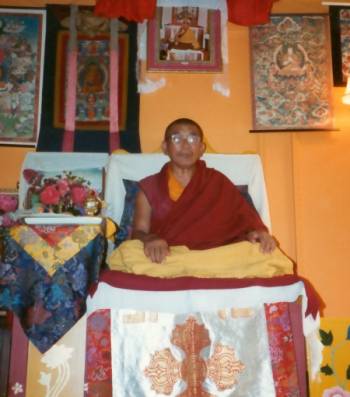
Khensur Yeshé Thubten Rinpoche
Lam Rim Teachings
Khensur Yeshé Thubten Rinpoche visited the Lam Rim Buddhist Centre a couple of times during the period that Ngala Nor’dzin and Ngala ’ö-Dzin frequented the centre, to give teachings on Lam Rim, the Graduated Path to Enlightenment. Most of the teachings that Ngala Nor’dzin and Ngala ’ö-Dzin received at the Lam Rim Centre were teachings on Lam Rim.
Ngala Nor’dzin comments:
Over a period of about five years, Ngala ’ö-Dzin and I attended retreats at the Lam Rim Centre almost every month. We received an extremely solid foundation in the fundamental teachings of Sutrayana. We have always felt that this was an excellent starting point for our lives as practitioners, and has helped us understand the apparent contradictions that seem to arise depending on the view being presented in a teaching. For example, receiving teachings on ‘The Song of the Owl-faced Dakini’ (The Ulukhamukha Dakini Upadesha Sutra or Heart Essence Sky-dancer Sutra of the Owl-faced Protector – ’ug-dong Khandro Nying-thig Do [’ug gDong mKha’ ’gro sNying thig mDo]) from Ngak’chang Rinpoche and Khandro Déchen for the first time, was like seeing something extremely familiar through a kaleidoscope – the somewhat linear understanding we had of these teachings exploded into a Dzogchen display of extraordinary subtlety and depth.
Ngala ’ö-Dzin remembers:
Sadly, Khensur Yeshé Thubten Rinpoche had recently suffered a stroke when we met him the first time, and was not at all well. Despite this, he freely and happily gave teachings. He was friendly and perfectly relaxed. Khensur Yeshé Thubten Rinpoche was quite an imposing figure, being taller than is usual for Tibetan people. We remember him as a most gentle and kind Lama.
Ngala Nor’dzin continues:
At Lam Rim, tsog ’khorlo was celebrated on alternate Sunday evenings, and we used to attend most of these occasions – sometimes with Ngak’chang Rinpoche who was always glad to particulate in tsog ’khorlo. Meditation practices were often led by Getsülma Tsültrim Zangmo and it was through her inspiration that we first experienced the value of a personal relationship with a dedicated practitioner. We were devoted to Tsültrim – but she did not regard herself as a teacher who could accept responsibility for personal students. Due to this, she encouraged us to spend more time with Ngak’chang Rinpoche and receive teaching and empowerment from him.
